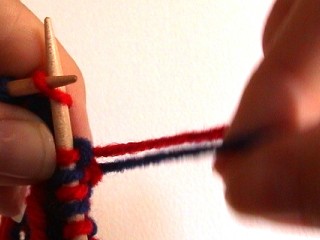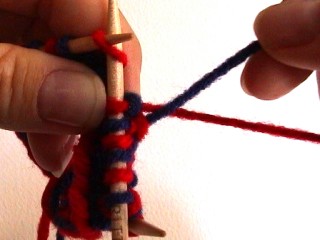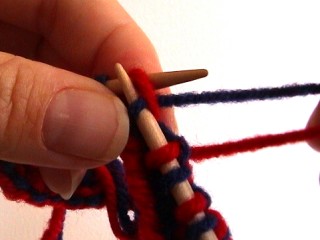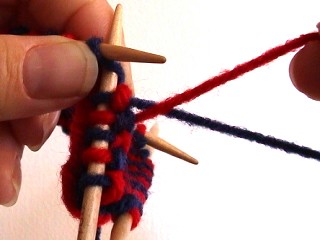I've used two balls of contrasting color yarn for these photographs, but obviously, if you're knitting from both ends of a single ball of yarn, the two strands will be of the same color.
There are several ways of casting on with two strands of yarn. The one I'm showing here is a single needle "long tail" type of cast-on, but with two strands and a short "tail" rather than one strand and a long "tail".

Make a slip knot with both strands. This "double stitch" doesn't count in the final number of stitch count since you'll be taking it off the needle when you start to knit.
 Cast on stitches with one strand over your forefinger and one over your thumb.
Cast on stitches with one strand over your forefinger and one over your thumb.
 When you start to knit, remove that first "double stitch" and pull ends to take out the slip knot.
When you start to knit, remove that first "double stitch" and pull ends to take out the slip knot.
 Join and begin knitting with the next stitch.
Join and begin knitting with the next stitch.
 Here are two strands of yarn. Yes? Now, I knit
continental normally. For this technique, I find it easier to hold the
yarn in my right hand and insert my right index finger between the strands
to make it easier to grab the next strand. Nobody said
this was a fast way to knit.
Here are two strands of yarn. Yes? Now, I knit
continental normally. For this technique, I find it easier to hold the
yarn in my right hand and insert my right index finger between the strands
to make it easier to grab the next strand. Nobody said
this was a fast way to knit.
 For the first stitch, use either strand.
Thereafter always take the other strand. In other words, never knit two consecutive stitches with
the same strand of yarn.
For the first stitch, use either strand.
Thereafter always take the other strand. In other words, never knit two consecutive stitches with
the same strand of yarn.
 Pass the working yarn (blue here) over the yarn from the previous stitch...
Pass the working yarn (blue here) over the yarn from the previous stitch...
 and knit with it.
and knit with it.
 Then pass the other strand over the stitch just
worked and knit with it. And on and on and so forth...
Then pass the other strand over the stitch just
worked and knit with it. And on and on and so forth...
Directions for decorative techniques get rather complicated like p1B, k1A, p1B, take B to back, k1A... with A being one strand and B being the other. There are some beautiful braided effects and stranding purl stitches across the front of the work. (Like in this rather poor quality picture.) The decorative effects can be made by knitting left handed with one strand and right handed with the other (and the yarn stays untangled) but it's not the same technique and doesn't give the firmness that the twisting does.

As you see here, all this twisting = a tangled mess.
Which is why I made this little primer about
detangling. :O)